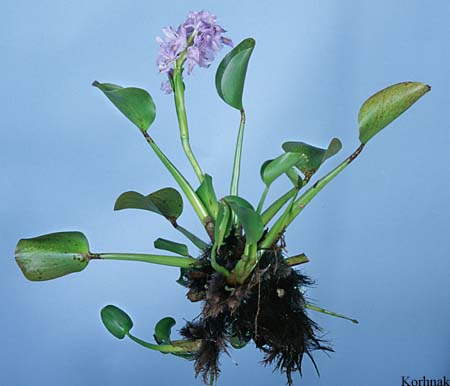Water Hyacinth
Eichhornia crassipes
Family: Pontederiaceae
Natural History

Individual plant of water hyacinth
Photo credit: Larry Korhnak, University of Florida
Water hyacinth, sometimes called water orchid, is an exotic plant that was introduced to the United States, from South America, in the late 1800's. This member of the Pontederiaceae family rapidly regenerates via runners, cuttings, or seeds, and has become one of the most serious pest weeds in the southeastern states. The seeds may lie dormant in the substrate and survive even extreme drought periods.
Water hyacinth is considered to be a serious environmental problem for wetlands in the gulf states, since the plants may double in growth in less than 20 days and quickly take over waterways. Expansive mats of growth may cut out light to submergent aquatic life forms, hinder navigation and water flow, and reduce oxygen levels, as these aggressive plants dominate aquatic ecosystems. A single acre of water hyacinths produces as much as 500 tons of decaying plant material per year. The decomposing detritus introduces excessive nutrient loads and depletes available oxygen, thus inhibiting survival of native plants and animals.
When growth of the plants can be strictly controlled, water hyacinth may be useful in purifying water, by filtering out excessive toxins and limiting algae. Biological controls are being investigated, such as the introduction of certain weevils and moths, as natural enemies of the plants.
In many parts of the world, uses are being sought for these aggressive weeds. In India, dried and ground water hyacinth roots are used to make briquettes of cooking fuel, or as a substitute for wood in the making of high-quality paper. The plants, which are high in nitrogen and potassium, are used as cattle forage, fertilizer, mulch and soil-binders. In Southeast Asia, water hyacinth plants are boiled and chopped for pig feed. Researchers are currently investigating the use of these plants as a source of commercial cellulose.
The fibrous roots of water hyacinth provide a sheltered habitat for many aquatic invertebrates and small fish, while the leaves and seeds are eaten by several species of wetland birds and waterfowl.
Water hyacinth is sometimes confused with frog's-bit (Limnobium spongia), a similar aquatic perennial. However, the stems of frog's-bit have a flattened side and lack inflated bulbs and their roots are white, instead of the distinctive black color of hyacinth roots.
Water hyacinth has become naturalized throughout most of the southeastern United States.

